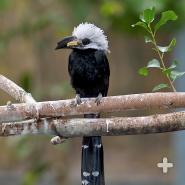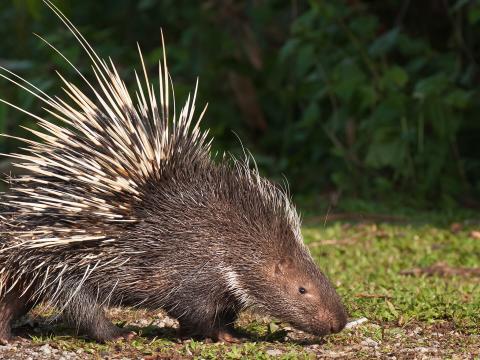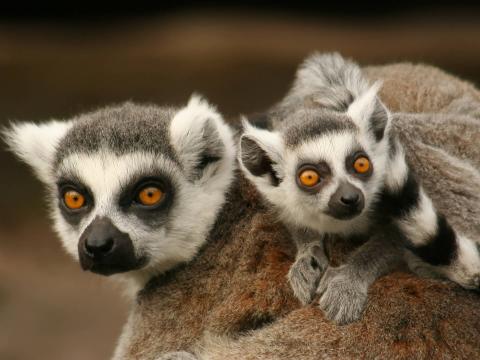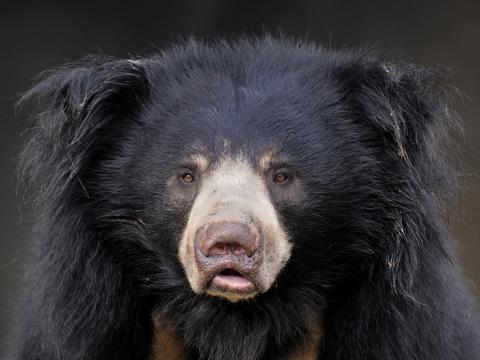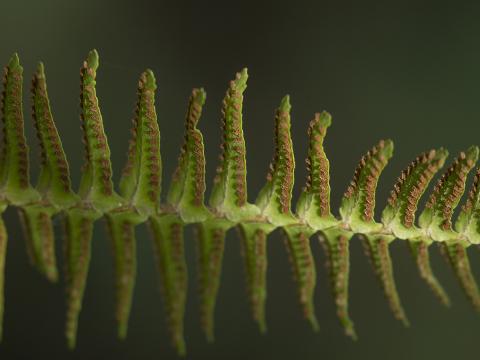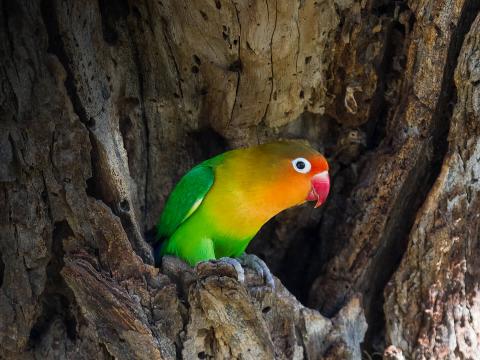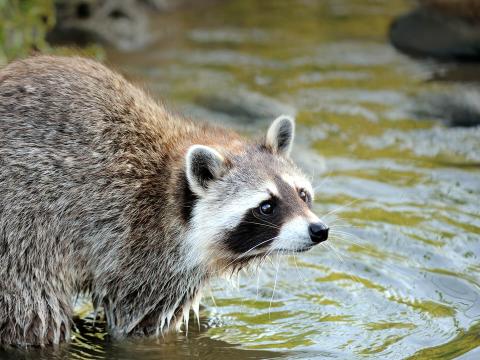Hornbill
- CLASS: Aves (Birds)
- ORDER: Coraciiformes
- FAMILY: Bucerotidae (hornbills), Bucorvidae (ground hornbills)
- GENERA: 16
- SPECIES: 59
ABOUT
I feel pretty: With long eyelashes, dark eyes, and an almost comically large, curved bill, hornbills have many admirers (the eyelashes are modified feathers!). These birds range from the size of a pigeon to large birds with a 6-foot (1.8 meters) wingspan. You can easily pick out a hornbill from other birds by a special body part atop their bill called a casque.
Hornbills have a long tail, broad wings, and white and black, brown, or gray feathers. This contrasts with the brightly colored neck, face, bill, and casque in many hornbill varieties. Females and males often have different colored faces and eyes. Their closest relatives are kingfishers, rollers, and bee-eaters.
In most hornbills, the casque is a hollow or spongy structure made out of keratin. It is believed that this structure acts as a vibrating chamber to make the hornbill's voice louder. The calls made by the bird range from deep booming sounds as they begin foraging to brays, toots, bellows, and cackles.
The bill and casque of juvenile birds are underdeveloped, and females often have a much smaller casque than males have. This may be because males also use their casque to attract mates and display their health and strength to other males. The males of some hornbill varieties even compete by knocking their casques together in mid-flight.
The casque of the helmeted hornbill from Borneo is different from all other hornbills: its dense, ivory-like casque makes up about 10 percent of the bird's body weight! Unfortunately, this has made it attractive to some people who kill the birds to use the heavy casques for ornamental carvings.
Hornbills have developed some interesting relationships with other wildlife. Eastern yellow-billed hornbills work with dwarf mongooses to gather food! The mongooses wait for the hornbills to arrive before setting out; if the hornbills arrive before the mongooses are up and about, the birds call down the mongooses’ burrow. Why? The hornbills benefit by eating all the insects stirred up by the foraging mongooses, and the mongooses gain extra eyes and ears to look out for danger.
The smallest hornbill, the red-billed dwarf hornbill, follows squirrels and swarms of driver ants to snatch up the insects that are disturbed. Even elephants in Africa and bears in Asia play a part in a hornbill's life by knocking down tree branches and creating perfect hollows for nesting sites.
HABITAT AND DIET
Found in Africa and Southeast Asia, hornbills live in forests, rainforests, or savannas, depending on species. But no matter where they live, hornbills are diurnal, often rising with the sun to preen and call to their neighbors before heading off for a meal. Some go off to forage in pairs or small groups while others gather in flocks that may number in the hundreds. In between meals, the birds preen themselves and each other and do a bit of sunbathing. Bill care is important, too, and the birds rub their bill and casque frequently across a branch or bark to keep them clean. When the day is done, they return to their home tree to roost.
It is also advantageous to roost in large groups—safety in numbers! Hornbills living in forests often roost on the thin outer branch of a tree as protection from climbing predators or on branches under the forest canopy to stay safe from aerial attacks—smaller hornbill varieties can become prey to large owls or eagles.
Most hornbills are omnivorous and eat a combination of fruit, insects, and other small wildlife. The birds can use the tip of their bill as a finger to pluck fruit from trees or animals off the ground. The edges of the bill are notched like a saw for grasping and tearing. The larger hornbills tend to eat mostly fruit and travel from tree to tree in pairs or large flocks.
There are two hornbill species that are unique because they are carnivorous and spend most of their time on the ground: Africa’s Abyssinian or northern hornbills and southern ground hornbills. These patrol their savanna territory on foot in groups of up to a dozen individuals. They eat mice and other rodents, frogs, and even venomous snakes, which they catch by using their long bill as tongs to keep out of harm's way.
Hornbills at the San Diego Zoo and the San Diego Zoo Safari Park eat a combination of fruit, yams, domestic cat and dog kibble, mice, crickets, and mealworms, with the carnivorous birds getting more meat items than the other types.
FAMILY LIFE
Hornbill courtship behaviors include a prospective pair vocalizing to one another, chasing each other, and slapping their bills together. The male must build trust with the female, so he demonstrates his devotion by bringing her food all year long. His loyalty is important, as she will be sealed up in a tree cavity with the eggs and the chicks for a few months.
The pair spends several days choosing just the right tree hollow to line with leaves, grass, and feathers. After breeding, the female uses regurgitated food, droppings, and mud brought to her by her mate to seal the opening of the tree hollow until only a small slit remains. This creates an almost predator-proof nest!
She lays her eggs and sits on them while the male flies back and forth bringing her whole or regurgitated food, which he feeds to her through the slit. The female keeps the nest clean by dropping all waste outside through the small opening. In some varieties, the female molts most of her wing and tail feathers at this time, leaving her unable to fly for several weeks. In others, the female breaks out of the hollow when the chicks are half grown; the chicks reseal themselves in the nest and are fed by both parents until they are ready to fledge.
Ground hornbills are the exception to this style of chick rearing. They do not seal the entrance to their nest and usually nest in holes in large tree trunks or palm stumps and also use hollow logs and holes on rock faces or dig holes in earth banks. Both male and female take turns incubating the eggs and tending to the chicks.
Hornbill chick eggs are laid several days apart, and the chicks hatch out at different times, naked and pink, with eyes closed. The oldest chick usually survives while the younger one(s) die from starvation: they can’t compete with their older, bigger sibling for food. The parents take turns feeding the chick. The young bird fledges after it is two months old but continues to stay with the parents as it learns to find food on its own. By four months, the youngster is ready to move out.
AT THE ZOO
The San Diego Zoo has a long history with Abyssinian ground hornbills. Our first, a four-year-old male, arrived at the Zoo in 1951. Named Charlie, he was eventually paired with a female that arrived in 1961, but they did not produce any offspring. When the female died in 1971, Charlie was sent to the San Diego Zoo Safari Park and paired with a new female, Susie, in 1972. In 1973, they successfully produced the first ground hornbill hatchling outside of Africa. This was such an outstanding achievement that it resulted in the 1974 Edward H. Bean Award, given to the Safari Park by the Association of Zoos and Aquariums “in recognition for the most notable birth." By 1995, Charlie and Susie had produced 43 chicks, many of which were then transferred to other zoos throughout North America. Today, we have hatched more than 500 hornbill chicks, which is among the highest number of hornbill hatchings in the world.
CONSERVATION
Despite their quirky and comical nature, hornbills are in trouble. Habitat destruction and hunting are the biggest threats to hornbills, and it is believed that there are only 120 pairs of Visayan wrinkled hornbills Aceros waldeni and fewer than 20 pairs of Sulu hornbills Anthracoceros montari left in the world. The Sulu hornbill's tiny population is limited to one island in the Philippines (Tawitawi), and military activity there makes conservation difficult. Other threats for hornbills include introduced species such as feral goats, which are preventing forest regeneration by eating new growth.
San Diego Zoo Wildlife Alliance is actively involved in conservation programs for hornbills. We partner with the Hornbill Nest Adoption Program, which employs local people (who may have previously earned money by poaching and selling hornbill chicks) as nest guardians, protecting hornbill nests from illegal logging and collecting data on the birds. This assists conservation efforts and also provides income and education opportunities. By supporting San Diego Zoo Wildlife Alliance, you are our ally in saving and protecting wildlife worldwide.





